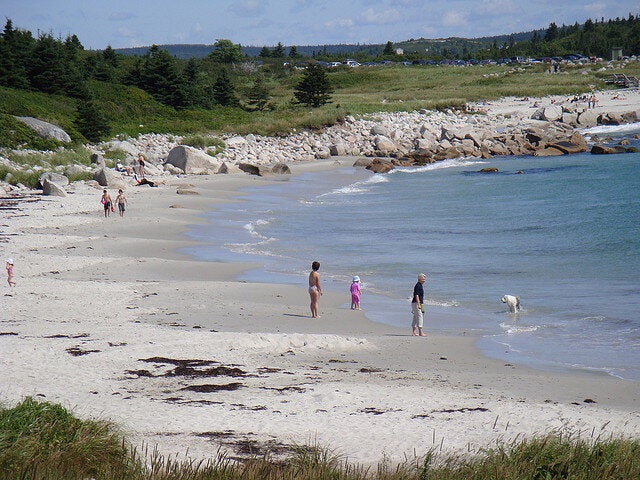It was the middle of July, just on the tail end of a sweltering hot stretch, when my boys and I headed out to Toronto's Cherry Beach for a swim. Everything checked out upon arrival. There was no parking to be found it was so packed. Music was blaring; people were having fun and hanging out. There were, I'd estimate, at least 2,500 people on the beach.
And four in the water.
And those four were shivering, complaining, and soon to head back to the foot-burning sand.
I had checked the weather. It was 35 degrees celsius, but The Weather Network told me it felt like 43. I didn't disagree, it was searing. But I should have checked the water temperature. It was, almost unbelievably, seven or eight -- even during the hottest part of the day.
Although that day was a post-storm extreme, the fact is that Toronto beaches are cold. And often they are not even you'll-get-used-to-it cold, but too cold to swim in comfortably, no matter how hot it is above water.
There are some reasons for that, and it's not likely to change soon.
To begin with, Lake Ontario is cold because it's deep. With a maximum depth of 244 meters and an average depth of 86 meters, it's much deeper than comparably-sized Lake Erie, which has maximum depth of 64 meters and an average depth of 19 meters. All of that extra depth means there are hundreds more cubic kilometers of water deprived of sunlight, making them cold -- almost ice cold.
Mark Mattson, president of the Lake Ontario Waterkeeper, points out that the bottom of the lake is hardly even, and that the west side of Lake Ontario is, on average, much deeper than the east side, particularly around Prince Edward County and the Thousand Islands. In fact, he grew up on Wolfe Island, and had no problem swimming in that part of Lake Ontario.
"The western part of the lake is on something of a shelf, so it feels more like Lake Erie water," he said. "But near Toronto, the drop-off is steep -- the deep water cooling pipe they put in near the islands is 55 meters underwater."
He also points out that where the beaches are located has not helped them be any warmer. "Unlike many Canadian cities, Toronto doesn't have beaches on its rivers," he said. "In fact, it doesn't have many beaches at all -- just 11 on more than 50 km of waterfront -- and they just happen to be situated at some of the coldest spots."
Even with its uneven bottom, if the lake were perfectly still and calm, there would be an upper layer about 15 to 20 meters deep of warm water and a lower layer of almost freezing water below that. But it's not perfectly calm. Winds, especially storms, can mix the two, bringing numbingly cold water to the surface.
Jay Austin, associate professor at University of Minnesota-Duluth's Large Lakes Observatory, likens the waters of the Great Lakes to vinaigrette. "Anywhere in lake 20 meters deep, the water is low 40s, high 30s (Fahrenheit) all year long, always cold," he said. "And the warm water, lighter, is like oil on top of vinegar. When you give it a shake, it mixes, and the normally sequestered (or capped) cold water can mix with the warm upper layer. Strong enough winds can send top layer away completely and it gets replaced by cold water."
Because of all of the other attributes Toronto's waterfront has, it's the one most likely to have icy-cold water at the surface after a storm, no matter what the season. As I was interviewing him, Austin pointed out that he had a buoy near the exact center of the lake with a current surface temperature reading of 22 degrees celsius, the water temperature at Cherry Beach at the same time was about 12 degrees.
Atmospheric Scientist Angela Fitz of the Weather Underground agrees with Austin, pointing out that the phenomenon of cold, deep water coming to the surface is called "upwelling." And she says that prevailing wind patterns are such that the warm water is frequently blowing away from Toronto's shoreline to be enjoyed by the people of Hamilton and New York State.
So, while Toronto will never be a swimmer's paradise, the constant recycling of cold water from the depth of the lake has some benefits.
One of them is that it gives us a healthy fishery. Desirable, deep-water fish like salmon and trout follow the edge of the cold-water zone and are often much closer to shore near Toronto than other parts of the lake.
And the process makes our drinking water cleaner. Mattson said that when sewage and runoff from Toronto -- sometimes as much as 9 billion liters in a year -- are quickly diffused in the cold, moving water. In contrast, Chicago -- which has very pleasant beaches -- has had to build canals to redirect its sewage and runoff away from warm, shallow Lake Michigan since 1925.
For fishing and drinking, Toronto's water is hard to beat. But if you want to go swimming, it makes sense to take a road trip.
